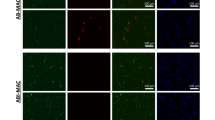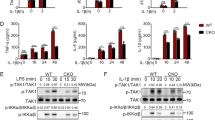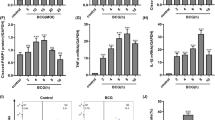Abstract
The tuberous sclerosis complex 1 (TSC1) is a tumor suppressor that inhibits the mammalian target of rapamycin (mTOR), which serves as a key regulator of inflammatory responses after bacterial stimulation in monocytes, macrophages, and primary dendritic cells. Previous studies have shown that TSC1 knockout (KO) macrophages produced increased inflammatory responses including tumor necrosis factor-α (TNF-α) and IL-12 to pro-inflammatory stimuli, but whether and how TSC1 regulates pro-IL-1β expression remains unclear. Here using a mouse model in which myeloid lineage-specific deletion of TSC1 leads to constitutive mTORC1 activation, we found that TSC1 deficiency resulted in impaired expression of pro-IL-1β in macrophages following lipopolysaccharide stimulation. Such decreased pro-IL-1β expression in TSC1 KO macrophages was rescued by reducing mTORC1 activity with rapamycin or deletion of mTOR. Rictor deficiency has no detectable effect on pro-IL-1β synthesis, suggesting that TSC1 positively controls pro-IL-1β expression through mTORC1 pathway. Moreover, mechanism studies suggest that mTORC1-mediated downregulation of the CCAAT enhancer-binding protein (C/EBPβ) critically contributes to the defective pro-IL-1β expression. Overall, these findings highlight a critical role of TSC1 in regulating innate immunity by control of the mTOR1-C/EBPβ pathway.
This is a preview of subscription content, access via your institution
Access options
Subscribe to this journal
Receive 12 digital issues and online access to articles
$119.00 per year
only $9.92 per issue
Buy this article
- Purchase on Springer Link
- Instant access to full article PDF
Prices may be subject to local taxes which are calculated during checkout






Similar content being viewed by others
References
Fujiwara N, Kobayashi K . Macrophages in inflammation . Curr Drug Targets Inflamm Allergy 2005 ; 4 : 281 – 286.
Gordon S, Taylor PR . Monocyte and macrophage heterogeneity . Nat Rev Immunol 2005 ; 5 : 953 – 964.
Mosser DM, Edwards JP . Exploring the full spectrum of macrophage activation . Nat Rev Immunol 2008 ; 8 : 958 – 969.
Sindrilaru A, Peters T, Wieschalka S, Baican C, Baican A, Peter H et al . An unrestrained proinflammatory M1 macrophage population induced by iron impairs wound healing in humans and mice . J Clin Invest 2011 ; 121 : 985 – 997.
Hu X, Liu G, Hou Y, Shi J, Zhu L, Jin D et al . Induction of M2-like macrophages in recipient NOD-scid mice by allogeneic donor CD4(+)CD25(+) regulatory T cells . Cell Mol Immunol 2012 ; 9 : 464 – 472.
Qin H, Holdbrooks AT, Liu Y, Reynolds SL, Yanagisawa LL, Benveniste EN . SOCS3 deficiency promotes M1 macrophage polarization and inflammation . J Immunol 2012 ; 189 : 3439 – 3448.
Dinarello CA . Immunological and inflammatory functions of the interleukin-1 family . Annu Rev Immunol 2009 ; 27 : 519 – 550.
Apte RN, Dotan S, Elkabets M, White MR, Reich E, Carmi Y et al . The involvement of IL-1 in tumorigenesis, tumor invasiveness, metastasis and tumor-host interactions . Cancer Metastasis Rev 2006 ; 25 : 387 – 408.
Apte RN, Voronov E . Is interleukin-1 a good or bad ‘guy’ in tumor immunobiology and immunotherapy? Immunol Rev 2008 ; 222 : 222 – 241.
Carmi Y, Voronov E, Dotan S, Lahat N, Rahat MA, Fogel M et al . The role of macrophage-derived IL-1 in induction and maintenance of angiogenesis . J Immunol 2009 ; 183 : 4705 – 4714.
Voronov E, Shouval DS, Krelin Y, Cagnano E, Benharroch D, Iwakura Y et al . IL-1 is required for tumor invasiveness and angiogenesis . Proc Natl Acad Sci U S A 2003 ; 100 : 2645 – 2650.
Sheedy FJ, Moore KJ . IL-1 signaling in atherosclerosis: sibling rivalry . Nat Immunol 2013 ; 14 : 1030 – 1032.
Alghasham A, Rasheed Z . Therapeutic targets for rheumatoid arthritis: Progress and promises . Autoimmunity 2014 ; 47 : 77 – 94.
Basak C, Pathak SK, Bhattacharyya A, Mandal D, Pathak S, Kundu M . NF-kappaB- and C/EBPbeta-driven interleukin-1beta gene expression and PAK1-mediated caspase-1 activation play essential roles in interleukin-1beta release from Helicobacter pylori lipopolysaccharide-stimulated macrophages . J Biol Chem 2005 ; 280 : 4279 – 4288.
Chan C, Li L, McCall CE, Yoza BK . Endotoxin tolerance disrupts chromatin remodeling and NF-kappaB transactivation at the IL-1beta promoter . J Immunol 2005 ; 175 : 461 – 468.
Zhang Y, Saccani S, Shin H, Nikolajczyk BS . Dynamic protein associations define two phases of IL-1beta transcriptional activation . J Immunol 2008 ; 181 : 503 – 512.
Martinon F, Burns K, Tschopp J . The inflammasome: a molecular platform triggering activation of inflammatory caspases and processing of proIL-beta . Mol Cell 2002 ; 10 : 417 – 426.
Dibble CC, Elis W, Menon S, Qin W, Klekota J, Asara JM et al . TBC1D7 is a third subunit of the TSC1-TSC2 complex upstream of mTORC1 . Mol Cell 2012 ; 47 : 535 – 546.
Pan H, O’Brien TF, Zhang P, Zhong XP . The role of tuberous sclerosis complex 1 in regulating innate immunity . J Immunol 2012 ; 188 : 3658 – 3666.
Weichhart T, Saemann MD . The multiple facets of mTOR in immunity . Trends Immunol 2009 ; 30 : 218 – 226.
Ohtani M, Nagai S, Kondo S, Mizuno S, Nakamura K, Tanabe M et al . Mammalian target of rapamycin and glycogen synthase kinase 3 differentially regulate lipopolysaccharide-induced interleukin-12 production in dendritic cells . Blood 2008 ; 112 : 635 – 643.
Schmitz F, Heit A, Dreher S, Eisenacher K, Mages J, Haas T et al . Mammalian target of rapamycin (mTOR) orchestrates the defense program of innate immune cells . Eur J Immunol 2008 ; 38 : 2981 – 2992.
Zhu L, Yang T, Li L, Sun L, Hou Y, Hu X et al . TSC1 controls macrophage polarization to prevent inflammatory disease . Nat Commun 2014 ; 5 : 4696.
Byles V, Covarrubias AJ, Ben-Sahra I, Lamming DW, Sabatini DM, Manning BD, Horng T . The TSC-mTOR pathway regulates macrophage polarization . Nat Commun 2013 ; 4 : 2834.
Weichhart T, Haidinger M, Katholnig K, Kopecky C, Poglitsch M, Lassnig C et al . Inhibition of mTOR blocks the anti-inflammatory effects of glucocorticoids in myeloid immune cells . Blood 2011 ; 117 : 4273 – 4283.
Harris J, Hartman M, Roche C, Zeng SG, O’Shea A, Sharp FA et al . Autophagy controls IL-1beta secretion by targeting pro-IL-1beta for degradation . J Biol Chem 2011 ; 286 : 9587 – 9597.
Chen H, Zhang L, Zhang H, Xiao Y, Shao L, Li H et al . Disruption of TSC1/2 signaling complex reveals a checkpoint governing thymic CD4+ CD25+ Foxp3+ regulatory T-cell development in mice . Faseb J 2013 ; 27 : 3979 – 3990.
Zhang L, Zhang H, Li L, Xiao Y, Rao E, Miao Z et al . TSC1/2 signaling complex is essential for peripheral naive CD8+ T cell survival and homeostasis in mice . PLoS One 2012 ; 7 : e30592.
Sun C, Sun L, Ma H, Peng J, Zhen Y, Duan K et al . The phenotype and functional alterations of macrophages in mice with hyperglycemia for long term . J Cell Physiol 2012 ; 227 : 1670 – 1679.
Inaba K, Inaba M, Romani N, Aya H, Deguchi M, Ikehara S et al . Generation of large numbers of dendritic cells from mouse bone marrow cultures supplemented with granulocyte/macrophage colony-stimulating factor . J Exp Med 1992 ; 176 : 1693 – 1702.
Fleetwood AJ, Dinh H, Cook AD, Hertzog PJ, Hamilton JA . GM-CSF- and M-CSF-dependent macrophage phenotypes display differential dependence on type I interferon signaling . J Leukoc Biol 2009 ; 86 : 411 – 421.
Wu T, Sun C, Chen Z, Zhen Y, Peng J, Qi Z et al . Smad3-deficient CD11b(+)Gr1(+) myeloid-derived suppressor cells prevent allograft rejection via the nitric oxide pathway . J Immunol 2012 ; 189 : 4989 – 5000.
Urbanska M, Gozdz A, Swiech LJ, Jaworski J . Mammalian target of rapamycin complex 1 (mTORC1) and 2 (mTORC2) control the dendritic arbor morphology of hippocampal neurons . J Biol Chem 2012 ; 287 : 30240 – 30256.
Julien LA, Carriere A, Moreau J, Roux PP . mTORC1-activated S6K1 phosphorylates Rictor on threonine 1135 and regulates mTORC2 signaling . Mol Cell Biol 2010 ; 30 : 908 – 921.
Ishida T, Mizushima S, Azuma S, Kobayashi N, Tojo T, Suzuki K et al . Identification of TRAF6, a novel tumor necrosis factor receptor-associated factor protein that mediates signaling from an amino-terminal domain of the CD40 cytoplasmic region . J Biol Chem 1996 ; 271 : 28745 – 28748.
Wesche H, Henzel WJ, Shillinglaw W, Li S, Cao Z . MyD88: an adapter that recruits IRAK to the IL-1 receptor complex . Immunity 1997 ; 7 : 837 – 847.
Muzio M, Ni J, Feng P, Dixit VM . IRAK (Pelle) family member IRAK-2 and MyD88 as proximal mediators of IL-1 signaling . Science 1997 ; 278 : 1612 – 1615.
Lai TY, Wu SD, Tsai MH, Chuang EY, Chuang LL, Hsu LC, Lai LC . Transcription of Tnfaip3 is regulated by NF-kappaB and p38 via C/EBPbeta in activated macrophages . PLoS One 2013 ; 8 : e73153.
Yang Z, Wara-Aswapati N, Chen C, Tsukada J, Auron PE . NF-IL6 (C/EBPbeta ) vigorously activates il1b gene expression via a Spi-1 (PU.1) protein-protein tether . J Biol Chem 2000 ; 275 : 21272 – 21277.
Cogswell JP, Godlevski MM, Wisely GB, Clay WC, Leesnitzer LM, Ways JP, Gray JG . NF-kappa B regulates IL-1 beta transcription through a consensus NF-kappa B binding site and a nonconsensus CRE-like site . J Immunol 1994 ; 153 : 712 – 723.
Godambe SA, Chaplin DD, Takova T, Bellone CJ . Upstream NFIL-6-like site located within a DNase I hypersensitivity region mediates LPS-induced transcription of the murine interleukin-1 beta gene . J Immunol 1994 ; 153 : 143 – 152.
Godambe SA, Chaplin DD, Takova T, Bellone CJ . An NFIL-6 sequence near the transcriptional initiation site is necessary for the lipopolysaccharide induction of murine interleukin-1 beta . DNA Cell Biol 1994 ; 13 : 561 – 569.
Tengku-Muhammad TS, Hughes TR, Ranki H, Cryer A, Ramji DP . Differential regulation of macrophage CCAAT-enhancer binding protein isoforms by lipopolysaccharide and cytokines . Cytokine 2000 ; 12 : 1430 – 1436.
Weichhart T, Costantino G, Poglitsch M, Rosner M, Zeyda M, Stuhlmeier KM et al . The TSC-mTOR signaling pathway regulates the innate inflammatory response . Immunity 2008 ; 29 : 565 – 577.
Haidinger M, Poglitsch M, Geyeregger R, Kasturi S, Zeyda M, Zlabinger GJ et al . A versatile role of mammalian target of rapamycin in human dendritic cell function and differentiation . J Immunol 2010 ; 185 : 3919 – 3931.
Bauernfeind FG, Horvath G, Stutz A, Alnemri ES, MacDonald K, Speert D et al . Cutting edge: NF-kappaB activating pattern recognition and cytokine receptors license NLRP3 inflammasome activation by regulating NLRP3 expression . J Immunol 2009 ; 183 : 787 – 791.
Dan HC, Adli M, Baldwin AS . Regulation of mammalian target of rapamycin activity in PTEN-inactive prostate cancer cells by I kappa B kinase alpha . Cancer Res 2007 ; 67 : 6263 – 6269.
Dan HC, Baldwin AS . Differential involvement of IkappaB kinases alpha and beta in cytokine- and insulin-induced mammalian target of rapamycin activation determined by Akt . J Immunol 2008 ; 180 : 7582 – 7589.
Lee DF, Kuo HP, Chen CT, Hsu JM, Chou CK, Wei Y et al . IKK beta suppression of TSC1 links inflammation and tumor angiogenesis via the mTOR pathway . Cell 2007 ; 130 : 440 – 455.
Ermolaeva MA, Michallet MC, Papadopoulou N, Utermohlen O, Kranidioti K, Kollias G et al . Function of TRADD in tumor necrosis factor receptor 1 signaling and in TRIF-dependent inflammatory responses . Nat Immunol 2008 ; 9 : 1037 – 1046.
Pobezinskaya YL, Kim YS, Choksi S, Morgan MJ, Li T, Liu C, Liu Z . The function of TRADD in signaling through tumor necrosis factor receptor 1 and TRIF-dependent Toll-like receptors . Nat Immunol 2008 ; 9 : 1047 – 1054.
Ghosh S, Tergaonkar V, Rothlin CV, Correa RG, Bottero V, Bist P et al . Essential role of tuberous sclerosis genes TSC1 and TSC2 in NF-kappaB activation and cell survival . Cancer Cell 2006 ; 10 : 215 – 226.
Tanaka K, Babic I, Nathanson D, Akhavan D, Guo D, Gini B et al . Oncogenic EGFR signaling activates an mTORC2-NF-kappaB pathway that promotes chemotherapy resistance . Cancer Discov 2011 ; 1 : 524 – 538.
O’Hayre M, Degese MS, Gutkind JS . Novel insights into G protein and G protein-coupled receptor signaling in cancer . Curr Opin Cell Biol 2014 ; 27 : 126 – 135.
Welm AL, Timchenko NA, Darlington GJ . C/EBPalpha regulates generation of C/EBPbeta isoforms through activation of specific proteolytic cleavage . Mol Cell Biol 1999 ; 19 : 1695 – 1704.
Luedde T, Duderstadt M, Streetz KL, Tacke F, Kubicka S, Manns MP, Trautwein C . C/EBP beta isoforms LIP and LAP modulate progression of the cell cycle in the regenerating mouse liver . Hepatology 2004 ; 40 : 356 – 365.
Jundt F, Raetzel N, Muller C, Calkhoven CF, Kley K, Mathas S et al . A rapamycin derivative (everolimus) controls proliferation through down-regulation of truncated CCAAT enhancer binding protein {beta} and NF-{kappa}B activity in Hodgkin and anaplastic large cell lymphomas . Blood 2005 ; 106 : 1801 – 1807.
Acknowledgements
The authors wish to thank Dr Chenming Sun, Dr Lina Sun, and Mr Steven Shao for their kind review of the manuscript. This work was supported by grants from the National Basic Research Program of China (2011CB710903, 2010CB945301, Yong Zhao), the National Natural Science Foundation of China for General and Key Programs (C81130055, C81072396, Yong Zhao), and the CAS/SAFEA International Partnership Program for Creative Research Teams (Yong Zhao).
Author information
Authors and Affiliations
Ethics declarations
Competing interests
The authors declare no competing financial interests.
Additional information
Supplementary Information accompanies the paper on Cellular & Molecular Immunology’s website (http://www.nature.com/cmi).
Supplementary information
Rights and permissions
About this article
Cite this article
Yang, T., Zhu, L., Zhai, Y. et al. TSC1 controls IL-1β expression in macrophages via mTORC1-dependent C/EBPβ pathway. Cell Mol Immunol 13, 640–650 (2016). https://doi.org/10.1038/cmi.2015.43
Received:
Revised:
Accepted:
Published:
Issue Date:
DOI: https://doi.org/10.1038/cmi.2015.43



